Do you want to ensure the vines you plan to grow this season have purple flowers? The good news is that there are many purple-flowering vines and climbers to choose from.
This page will teach you more about purple-flowering vines and climbing plants. It also includes details on where to grow and care for these lovely creeping plants and images of them.
1. Blue Sky Vine
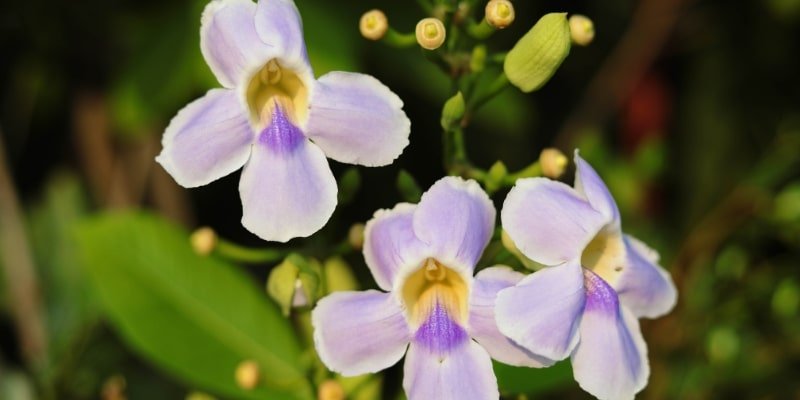 Scientific Name: Thunbergia grandiflora
Scientific Name: Thunbergia grandiflora
Plant Type: Perennial, Annual
Geographic Origin: India and South Asia
Plant Size: 15 to 30 feet
Sun Exposure: Full sun or partial shade
Plant Zone: 8-11
Geographic Origin: India and South Asia
The blue sky vine (Thunbergia grandiflora), a showy relative of the black-eyed Susan vine, bears abundant large, purplish-blue, cup-shaped flowers with golden throats. This quick-growing perennial vine, sometimes known as the Bengal clock vine, thrives in moderate climes.
In the winter, it can be taken inside as a houseplant in the colder northern climates. Blue sky vine is an annual that grows up to 8 feet in a single growing season.
2. Clematis
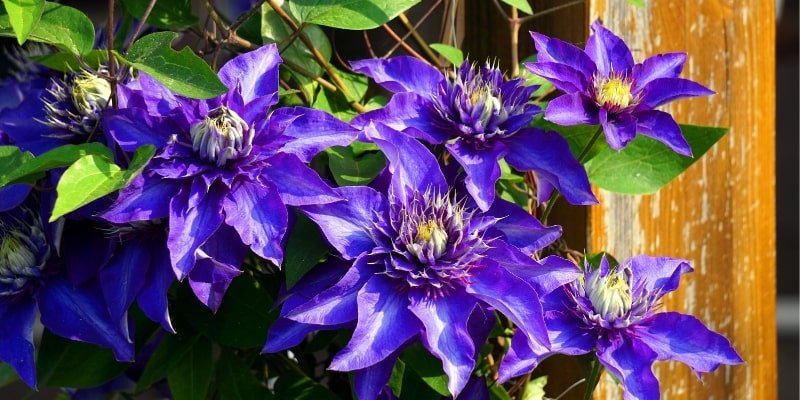 Scientific Name: Clematis viticella
Scientific Name: Clematis viticella
Plant Type: Perennial
Plant Size: 10 to 15 feet
Sun Exposure: Full sun or partial shade
Plant Zone: 4
Geographic Origin: China, Japan, Europe
Clematis is a fantastic plant with various colours and flower shapes, including double and single blooms. It can easily climb a fence, mailbox, or arbour. Another container option is dwarf clematis, which reaches a height of only three feet.
Growing clematis vines is simple if you abide by the proverb that says they prefer to have their “heads in the sun and their feet in the shade.” Plant them in broad light, but cover them with a thick layer of mulch to keep their roots cool and shaded.
3. Lavender Trumpet Vine
 Scientific Name: Clytostoma callistegioides
Scientific Name: Clytostoma callistegioides
Plant Type: Perennial
Plant Size: 15 to 20 feet
Sun Exposure: Full sun, partial shade
Plant Zone: 4 to 10
Geographic Origin: Brazil
The Lavender Trumpet Vine is a woody vine with dense foliage that bears flowers that are true to its Name. The gentle purple shading of these three-inch-wide blossoms wonderfully blends a pastel tone into your garden, giving them the appearance of a trumpet bell.
Because of its density, the lavender trumpet vine readily climbs any surface, including walls of houses or telephone poles. However, the vine can seriously harm its supporting structure if left unchecked. Pruning can control your lavender trumpet vine and stop it from taking over the surrounding habitat or your neighbours’ yard.
4. Twining Snapdragon
 Scientific Name: Antirrhinum kelloggii
Scientific Name: Antirrhinum kelloggii
Plant Type: Annual
Plant Size: 1 to 3 feet
Sun Exposure: Full sun, partial shade
Plant Zone: 9-10
Geographic Origin: North America
The Twining Snapdragon climbs other plants and leaves surfaces that resemble vines while not being a genuine vine. The flowers maintain the characteristic snout and mouth-like forms of the conventional Snapdragon.
The Twining Snapdragon’s beautiful purple or indigo blossoms may have white or blue highlights. This plant is smaller in stature because of its clinging, slender stalks. For denser or woodier plants, the Twining Snapdragon is a beautiful option if you don’t have a trellis or other comparable framework for a climbing vine.
5. Dutchman’s pipe
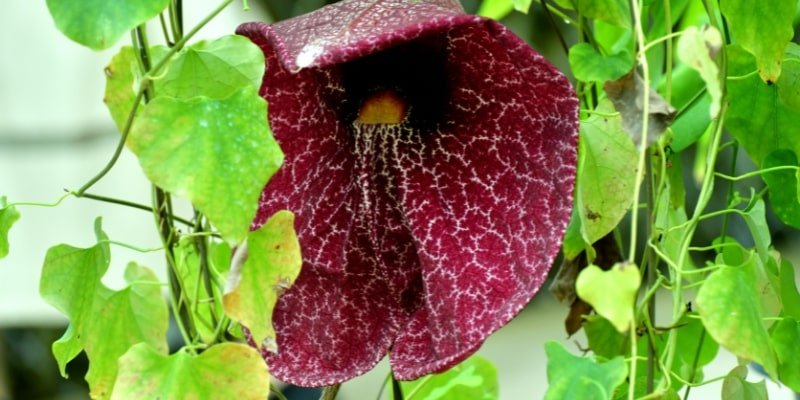 Scientific Name: Aristolochia gigantea
Scientific Name: Aristolochia gigantea
Plant Type: Perennial
Plant Size: 15 to 30 feet
Sun Exposure: Full sun, partial shade
Plant Zone: 10-12
Geographic Origin: North America
While Dutchman’s pipe isn’t the first vine many gardeners choose when searching for purple-flowering climbing vines; it’s a distinctive alternative to make your garden stand out. The flower’s shape and lobes, which mimic a Dutch smoking pipe, give rise to the moniker “Dutchman’s Pipe.”
The bloom features two to three dark maroon-purple lobes encircling a greenish-yellow flower. The Dutchman’s pipe plant does not thrive in drier soils; it prefers damp soil.
If ingested, this specific vine can lead to significant health problems. While the Dutchman’s pipe looks great wrapped over your trees, walls, or fence, it’s not a plant you want to eat.
6. Bougainvillea
 Scientific Name: Bougainvillea spectabilis
Scientific Name: Bougainvillea spectabilis
Plant Type: Perennial, Annual
Plant Size: 15 to 40 feet
Sun Exposure: Full sun
Plant Zone: 9-11
Geographic Origin: Brazil
The bougainvillea vine produces bright hues like orange, scarlet, and, of course, purple. Although the Bougainvillea’s flowers are tiny and white, the bracts—large, modified leaves—surround them with breathtaking colour.
The early spring blossoms of the Bougainvillea vine, which is thick and woody, continue into autumn. Bougainvillea is a worthwhile investment for any purple-loving gardener, producing one of the most vibrant purple vines. Remember that this plant is considered invasive in some parts of the nation.
7. Morning Glory
 Scientific Name: Ipomoea purpurea
Scientific Name: Ipomoea purpurea
Plant Type: Perennial, Annual
Plant Size: 6 to 10 feet
Sun Exposure: Full sun
Plant Zone: 2-11
Geographic Origin: Mexico, Central America
Ipomoea purpurea, a morning glory vine, proliferates and may easily climb railings, trellises, and other supports. This annual is easy to grow and comes in various colours.
Morning Glory’s 4—to 6-inch-wide blooms open in the morning and close by the afternoon, which is how it gets its Name. Although it frequently self-sows profusely, undesirable seedlings are easy to pull out.
8. Nightshade
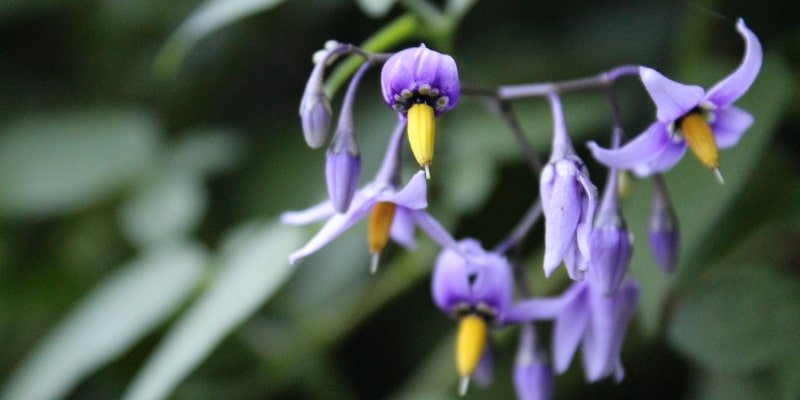 Scientific Name: Solanum anti
Scientific Name: Solanum anti
Plant Type: Perennial
Plant Size: 8 feet
Sun Exposure: Full sun to partial shade
Plant Zone: 7-10
Geographic Origin: North America
This variety of nightshade is called Purple Nightshade. It grows like a shrub but may climb nearby fences and other objects. Like other nightshade varieties, purple has a unique blossom with purple petals that flare around a bright yellow pistil.
Like many other purple-flowered climbing plants, the purple nightshade is toxic. Due to its toxicity, grazing animals like deer will avoid it. Planting purple nightshade can help gardeners deter deer and safeguard their other plants.
9. Hyacinth Bean Vine
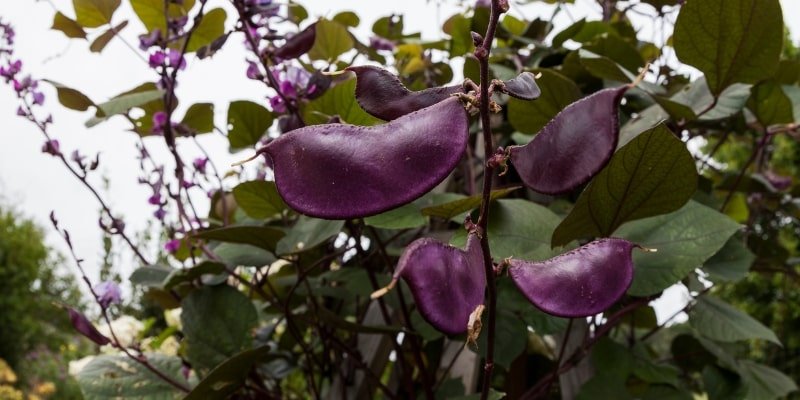 Scientific Name: Lablab purpureus
Scientific Name: Lablab purpureus
Plant Type: Annual
Plant Size: 10 to 15 feet
Sun Exposure: Full sun
Plant Zone: 10-11
Geographic Origin: Africa, Asia
The speed at which the hyacinth bean vine (Lablab purpureus) reaches for the sun will astound you. Its stunning green or purple foliage creates a fast-growing, vibrant canopy over arbors and trellises with gorgeous heads of pink and purple vine flowers.
Large, glossy, purple seed heads that resemble pea pods grow on the vines after the blooms fade and hang from the tips of each branch.
10. Purple Bell Vine
 Scientific Name: Rhodochiton atrosanguineus
Scientific Name: Rhodochiton atrosanguineus
Plant Type: Perennials
Plant Size: 8 to 10 feet
Sun Exposure: Full sun
Plant Zone: 10-11
Geographic Origin: North America
The purple bell vine (Rhodochiton atrosanguineus) is a fast-growing perennial vine with heart-shaped leaves and unusual, dangling blooms.
It is typically planted annually in frost-prone locations. One glance at this vine’s deep violet-pink blossoms reveals the rich crimson petal tubes, which dangle from bell-shaped calyces and resemble clappers.
The purple bell vine plant is one of many flowering vines that can grow in shadow but also does well in full sun. Start a purple bell vine from seed, and as it grows, train it up a pergola, trellis, or wall.
11. Cup and Saucer Vine
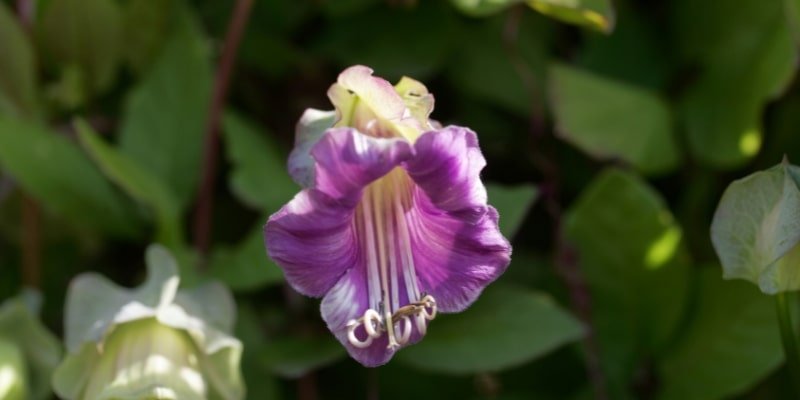 Scientific Name: Cobaea scandens
Scientific Name: Cobaea scandens
Plant Type: Perennials
Plant Size: 2 inches
Sun Exposure: Full sun
Plant Zone: 9-10
Geographic Origin: Mexico
As your yard matures, observe the fragrant purple-hued blossoms of the cup and saucer vine (Cobaea scandens). The vine’s bell-shaped (also called cup-shaped) flowers and green calyx give it its Name.
Climbing up to 20 feet in a single season, this fragile perennial vine grows best as an annual in milder climates. Plant cup and saucer vine seeds indoors 8 to 10 weeks before the final frost date in your location. A trellis, wall, fence, or arbor should be provided for this quickly spreading vine.
12. Purple Vining Roses
 Scientific Name: Rosa
Scientific Name: Rosa
Plant Type: Perennials
Plant Size: 5 Inches
Sun Exposure: Full sun to tolerate light shade
Plant Zone: 3-9
Geographic Origin: Asia
Vining roses are long, woody stem plants that can be trained to climb. All summer, your garden landscape will be adorned with vibrant height accents from the gorgeous purple, light pink, or lilac rose blossoms. You can adorn your landscape with climbing purple roses over arbors or gate entrances.
Supporting the growing arching canes will encourage roses to climb. Summertime sees water levels rise to the point where the land cannot absorb anymore.
13. Mandevilla Vine
 Scientific Name: Mandevilla sanderi
Scientific Name: Mandevilla sanderi
Plant Type: Annual, Perennial
Plant Size: 3–10 ft. tall
Sun Exposure: Full sun
Plant Zone: 9-11
Geographic Origin: Brazil
The enormous, funnel-shaped blossoms of the mandevilla vine, a tropical climbing plant, come in pink, purple, red, and white hues. Climbing plants like pergolas, trellises, and fences are ideal for them. Mandevilla vines grow nicely in evergreen hedges or privacy screens and blossom constantly throughout the season.
Mandevilla is a tropical climbing vine that grows annually in more excellent areas. The creeper can be planted in borders or garden beds if it receives full sun. It proliferates. Alternatively, cultivate this trailing plant in a hanging basket to enjoy its purple blossoms.
14. Climbing Nasturtium
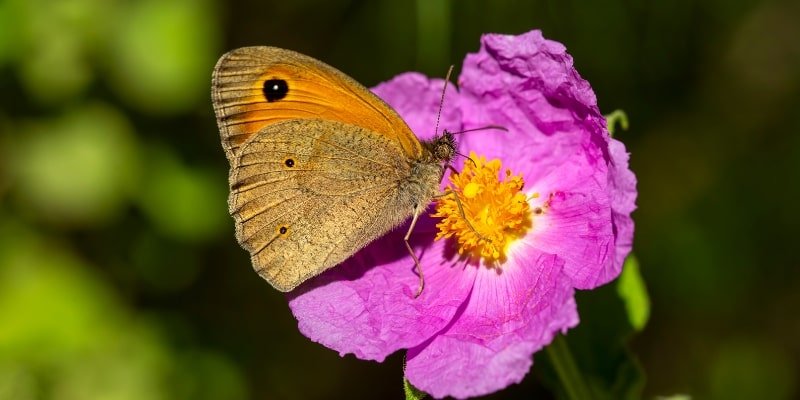 Scientific Name: Tropaeolum majus
Scientific Name: Tropaeolum majus
Plant Type: Annual
Plant Size: 5 to 6 feet
Sun Exposure: Full sun
Plant Zone: 9-11
Geographic Origin: South America
Climbing Nasturtiums feature broad, light-green foliage and purple, rose-like blooms on creeping vines. Twining stems can scale chain fences, mailbox posts, arbors, and trellises. In addition to the ‘Purple Emperor’ variety’s light purple flowers, other Nasturtium varieties feature bright orange, yellow, and vivid red flowers.
Nasturtium is a hardy annual climbing nasturtium that can be grown on the ground. This flowery vine grows annually in colder areas.
15. Sweet Pea
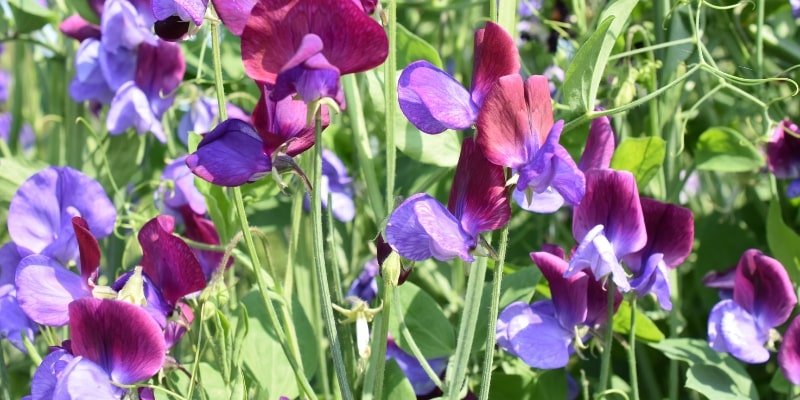 Scientific Name: Lathyrus odoratus
Scientific Name: Lathyrus odoratus
Plant Type: Annual
Plant Size: 5 to 6 feet
Sun Exposure: Full sun
Plant Zone: 3-8
Geographic Origin: Aegean Islands
Purple, pink, orange, red, and lilac blossoms adorn the stunning annual climbing vine known as sweet peas. Depending on the cultivar, sweet pea climbing plants vary in height from 6 to 8 feet (1.8 to 2.4 meters). Entwining or supporting the fragile stems is vital to aid in their high climbing.
Grow the flowering vines in whole light to reap the beautiful smells and quantities of sweet pea flower clusters. Sweet peas grow well in temperate regions and blossom from spring through autumn.
16. Garlic Vine
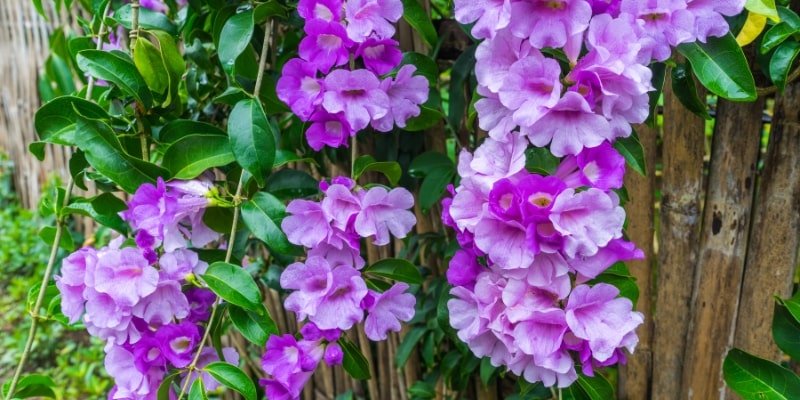 Scientific Name: Mansoa Alliance
Scientific Name: Mansoa Alliance
Plant Type: Perennial
Plant Size: 2m to 3m tall
Sun Exposure: Full sun
Plant Zone: 9-11
Geographic Origin: Northern South America
A climbing plant produces the garlic vine’s graceful purple-to-light lilac blossoms. The flowers of the lavender garlic vine bloom twice a year. Plus, when you smash the leaves, they smell like garlic.
Above, garlic vines grow in the earth. If they receive enough sunlight to flower, they can also be grown indoors in containers.
17. Butterfly Pea
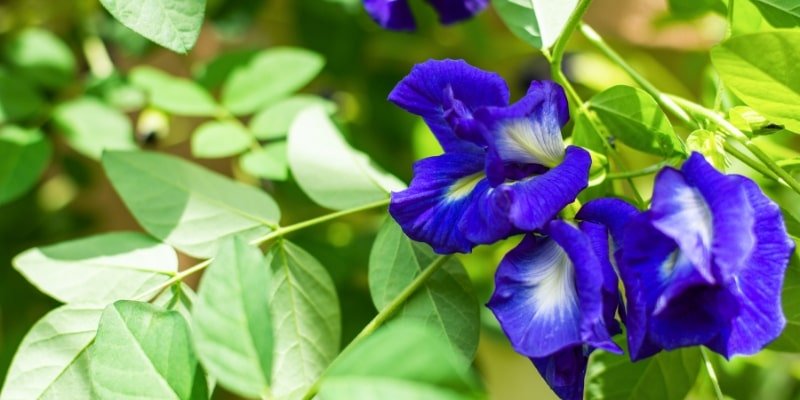 Scientific Name: Clitoria ternatea
Scientific Name: Clitoria ternatea
Plant Type: Perennial
Plant Size: 1 to 15 feet
Sun Exposure: Full sun
Plant Zone: 9-11
Geographic Origin: equatorial Asia
The butterfly pea blossom’s exquisite pale violet petals and dark purple veins belong to a climbing plant. Butterfly peas are delicate flowers that thrive best when included in a summer hedgerow because their thin stems require assistance to develop upward. Butterfly pea vines are annual plants that reach heights of.
18. Climbing Fuchsia
 Scientific Name: Fuchsia magellanica
Scientific Name: Fuchsia magellanica
Plant Type: Annual
Plant Size: 12- to-16-inch
Sun Exposure: Direct sun
Plant Zone: 8-10
Geographic Origin: South America
Purple, pink, and red blooms cling to shrubby climbing vines home to numerous fuchsia types. A vigorous climber, fuchsia blooms from spring through autumn with masses of dangling purple-pink or purple-red, bell-shaped flowers. The dark green, ovate leaves of the fuchsia vine have serrated edges.
The attractive purple vining fuchsia plants are perfect for flowering privacy screens, covering chain-link fences, and back-of-border plantings. Fuchsia species can also be grown as hanging basket plants with flowers.
19. Chocolate Vine
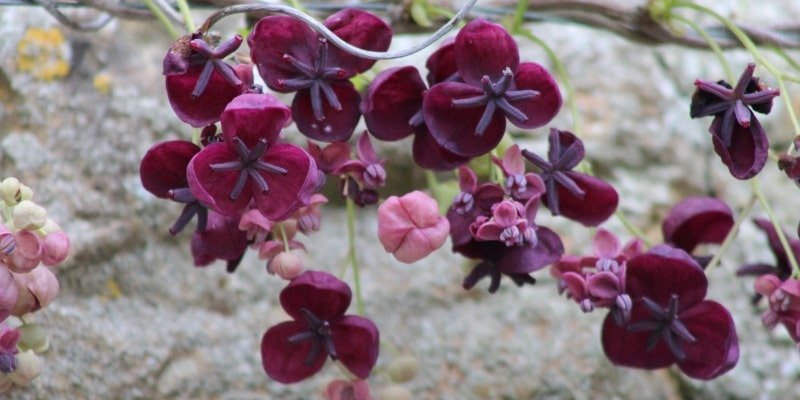 Scientific Name: Akebia quinata
Scientific Name: Akebia quinata
Plant Type: Perennial
Plant Size: 1–2 ft.
Sun Exposure: Full sun
Plant Zone: 4-9
Geographic Origin: Japan, China
Brownish-purple blooms and huge, palmately complex leaves characterize the deciduous, woody climbing plant known as the chocolate vine. Early spring brings the vine’s violet blossoms. This fast-growing woody vine, known as the Five-Leaf Akebia, bears purple sausage-shaped fruit.
20. Boston Ivy
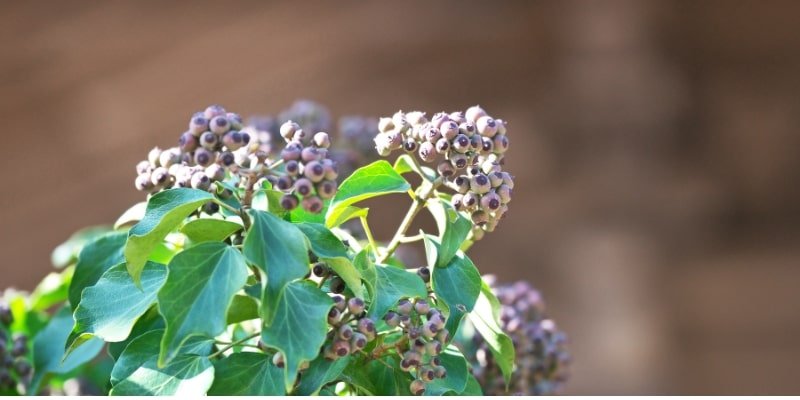 Scientific Name: eastern Asia
Scientific Name: eastern Asia
Plant Type: Perennial
Plant Size: 30-50 ft. tall
Sun Exposure: partial shade to full sun
Plant Zone: 3-9
Geographic Origin: Japan, China
Boston ivy is a robust climbing vine with subtle blooms and crimson, purplish-coloured foliage. Some climbing plants, other than Boston ivy, stay purple only some year-round. Certain varieties of Boston ivy feature purple leaves that turn green in the summer and reddish-red in the autumn.
Boston ivy’s distinctive, ivy-shaped leaves change colour with the seasons. You can only see purple berries once the climbing deciduous vine loses its leaves, following the ivy’s flowering season.
21. Chilean Potato Bush
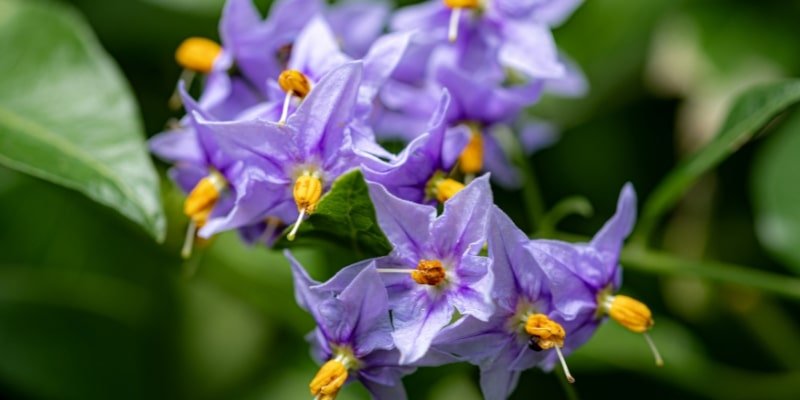 Scientific Name: Solanum crispum
Scientific Name: Solanum crispum
Plant Type: Perennial
Plant Size: 6 m
Sun Exposure: Full sun
Plant Zone: 7-11
Geographic Origin: Peruvian-Bolivian Andes
The blue potato shrub has broad, oval-to-elliptical leaves, but its spectacular flowers set this species apart. The plant is classified as deciduous in cooler climates, producing flowers from March to October, and as an evergreen in warmer climates, where it may produce flowers all year round.
Summertime is when flowering is most abundant. It produces little, vivid, orange-red oval berries that are inedible and bear toxic seeds.
22. Bush Clock Vine
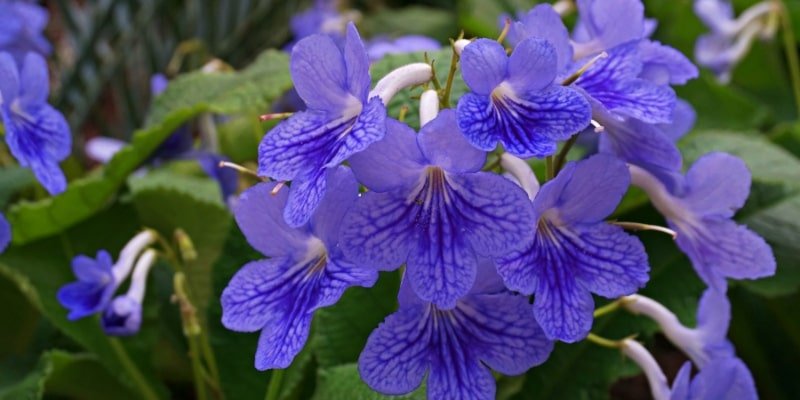 Scientific Name: Thunbergia erecta
Scientific Name: Thunbergia erecta
Plant Type: Annual plant
Plant Size: 2 ft
Sun Exposure: Direct Sunlight
Plant Zone: 5-9
Geographic Origin: West Africa
The bush clock vine, Thunbergia erecta, is indigenous to the tropical regions of Africa. It is highly valued for its breathtaking purple blossom show in the summer. The shape of this plant is determined by how much pruning it receives.
If left untrimmed, it will develop into a creeping mound; if lightly pruned frequently, it will grow into a low, bushy shrub. It is ideal for planting between border plants or around patios and piers. The dense vegetation is ideal for a low hedge row. Furthermore, this plant is naturally non-toxic.
23. Climbing Hydrangea
 Scientific Name: Hydrangea petiolaris
Scientific Name: Hydrangea petiolaris
Plant Type: Perennial
Plant Size: 30 – 40 feet
Sun Exposure: Full sun to part shade
Plant Zone: 5-9
Geographic Origin: Japan, Korea
Climbing hydrangea is an excellent option if you want gorgeous hydrangea flowers. With its vast clusters of white blooms, dark green leaves, and robust aerial roots, this woody-stemmed vine may easily cover a wall, fence, or arbour once it becomes established.
When arranged as dried flowers, their blossoms never stop offering. Please ensure the area you select for the vine’s planting can accommodate its eventual size. Cut off the vine’s dead or damaged branches as soon as it blooms if it gets too dense or overbearing.
24. Firecracker Vine
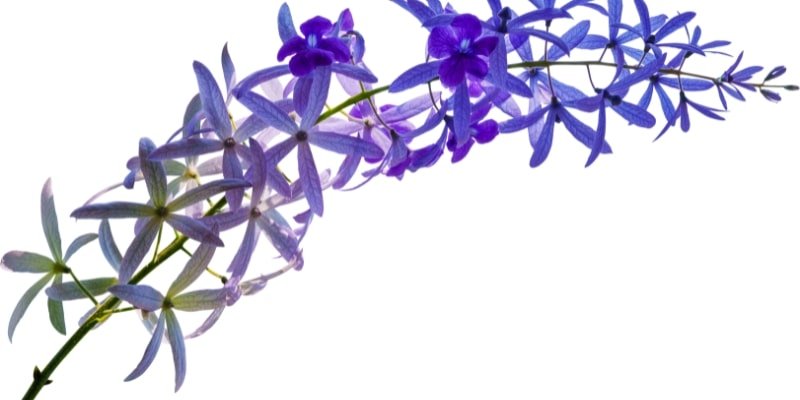 Scientific Name: Ipomoea lobata
Scientific Name: Ipomoea lobata
Plant Type: Annual
Plant Size: 3 to 4 feet tall
Sun Exposure: Full sun
Plant Zone: 4-9
Geographic Origin: Northeastern Mexico
The firecracker vine, often called the Spanish flag, blooms in a riot of colour. As the tubular-shaped blossoms mature, they progressively fade from red to orange and yellow. Butterflies, hummingbirds, and other pollinators frequently stop by the bloom clusters.
If you reside in a more relaxed planting zone, consider growing the firecracker vine annually and replanting it every year from seed. However, it will not withstand freezing.
25. Virginia creeper
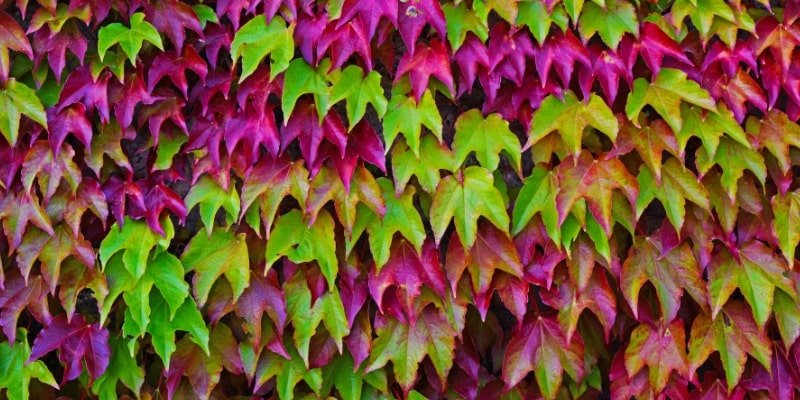 Scientific Name: Parthenocissus quinquefolia
Scientific Name: Parthenocissus quinquefolia
Plant Type: Perennial
Plant Size: 50 feet
Sun Exposure: Full sun and partial shade
Plant Zone: 3-9
Geographic Origin: Eastern North America
The autumn beauty of the Virginia creeper vine is breathtaking. The quick-growing Virginia creeper, a close relative of Boston ivy, can be planted in the autumn or spring. With its gripping tendrils supporting it, it is frequently used as ground cover or a climbing vine on stone walls and trellises.
Although birds can enjoy eating the dark blue berries of the Virginia creeper without injury, they contain lethal quantities of oxalic acid.

